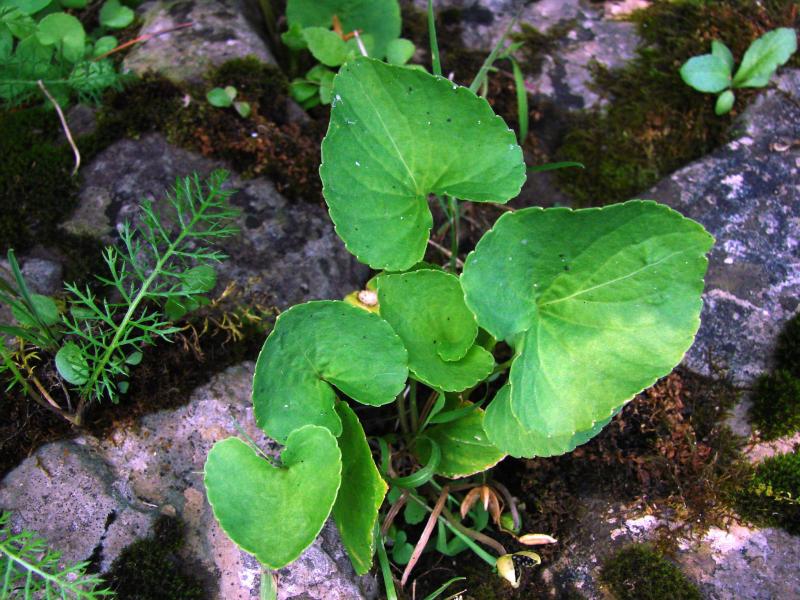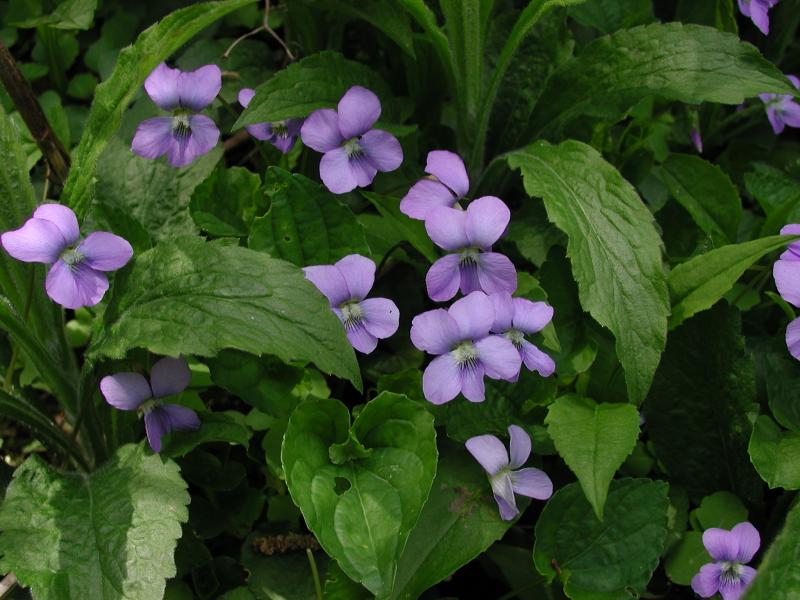Northern Bog Violet
Viola nephrophylla Greene
- Class
- Dicotyledoneae (Dicots)
- Family
- Violaceae (Violet Family)
- State Protection
- Endangered
Listed as Endangered by New York State: in imminent danger of extirpation in New York. For animals, taking, importation, transportation, or possession is prohibited, except under license or permit. For plants, removal or damage without the consent of the landowner is prohibited.
- Federal Protection
- Not Listed
- State Conservation Status Rank
- S1
Critically Imperiled in New York - Especially vulnerable to disappearing from New York due to extreme rarity or other factors; typically 5 or fewer populations or locations in New York, very few individuals, very restricted range, very few remaining acres (or miles of stream), and/or very steep declines.
- Global Conservation Status Rank
- G5
Secure globally - Common in the world; widespread and abundant (but may be rare in some parts of its range).
Summary
Did you know?
The species name "nephrophylla" means kidney-leaf, and refers to the shape of the basal leaves. Like most violets, this species produces "cleistogamous", meaning closed flowers as well as the familiar purple violet blossoms. These easily overlooked cleistogamous flowers never open and have no petals, and look like small bumps on the stems. They produce seeds by self-fertilization.
State Ranking Justification
There are only 4 verified occurrences and 7 historical occurrences known from New York. Only 2 of the verified occurrences are ranked as better than "fair". The historical occurrences date from the early 1900s, and most sites have never been re-checked.
Short-term Trends
More precise population data are needed to determine trends for this species, though none of the verified occurrences are known to have been extirpated or have undergone declines in recent years.
Long-term Trends
The long-term trend for this species is unclear; there are sixteen historical occurrences that should be searched for.
Conservation and Management
Threats
Trampling and erosion by human activity, and trampling and herbivory by deer, have been identified as threats to some of the known populations.
Conservation Strategies and Management Practices
Trails and human activity should be directed away from populations to prevent trampling. Some sites may need management to maintain an open aspect.
Habitat
Habitat
In New York Viola nephrophylla has been collected from a variety of cold, wetland habitats, including open marl fens within larger swamps, Northern White-cedar swamps and wet pastures. It also occupies calcareous shoreline outcrops and boreal heath barrens (New York Natural Heritage Program 2008). Gravelly (often calcareous) shores, slopes, bogs and open low grounds (Fernald 1970). Mainly in the western cordillera, but extending east in cold, wet places (often in a high pH) (Gleason and Cronquist 1991). Circumneutral soils of fens, ledges, and peaty shores (Haines and Vining 1998).
Associated Ecological Communities
- Alpine sliding fen*
(guide)
A shallow peat bog on 5-35 degree slopes on the brow of alpine or subalpine cliffs.
- Boreal heath barrens
(guide)
A dwarf shrubland or shrub-savanna dominated by heath or heath-like shrubs. Boreal heath barrens occur on nearly level outwash plains of the Adirondacks, in frost pockets lying in valleys.
- Calcareous shoreline outcrop
(guide)
A community that occurs along the shores of lakes and streams on outcrops of calcareous rocks such as limestone and dolomite. The vegetation is sparse; most plants are rooted in rock crevices.
- Marl fen
(guide)
A wetland that occurs on a bed of marl. Marl is a whitish substance that is deposited from water that has a lot of calcium dissolved in it. The whitish substance is calcium carbonate, people used to harvest marl to lime agricultural fields. The marl substrate is always saturated, may be flooded, and has a very high pH, generally greater than 7.5. The main source of water is always groundwater. The plants are often sparse and stunted. Marl fens may occur as small patches within a rich graminoid fen.
- Rich graminoid fen*
(guide)
A wetland of mostly grasses usually fed by water from highly calcareous springs or seepage. These waters have high concentrations of minerals and high pH values, generally from 6.0 to 7.8. Plant remains do not decompose rapidly and these grasses usually grow on older, undecomposed plant parts.
- Rich shrub fen*
(guide)
A wetland with many shrubs that is usually fed by water from springs and seeps. These waters have high concentrations of minerals and high pH values, generally from 6.0 to 7.8. Plant remains in these fens do not decompose rapidly and thus the plants in these fens usually grow on older, undecomposed woody plant parts.
- Rich sloping fen*
(guide)
A small, gently sloping wetland that occurs in a shallow depression on a slope composed of calcareous glacial deposits. Sloping fens are fed by small springs or groundwater seepage. Like other rich fens, their water sources have high concentrations of minerals and high pH values, generally from 6.0 to 7.8. They often have water flowing at the surface in small channels or rivulets.
* probable association but not confirmed.
Associated Species
- Cladium mariscoides (twig-rush)
- Eleocharis rostellata (walking spike-rush)
- Lobelia kalmii (Kalm's lobelia)
- Oligoneuron ohioense
- Solidago nemoralis
- Symphyotrichum lateriflorum (calico-aster)
- Triantha glutinosa (sticky false asphodel)
- Zigadenus sp.
Range
New York State Distribution
Viola nephrophylla is known from scattered locations in the western and northern parts of the state.
Identification Comments
General Description
Viola nephrophylla is a perennial wildflower species. Its leaves are hairless, and wider than long, with roughly kidney-shaped bases. It is a "stemless" species, the flowers borne singly on leafless stalks emerge directly from the base of the plants. In Viola nephrophylla the flowering stalks extend much above the flowers. The petals are blue, the bottom and two adjacent ones densely "bearded" with threadlike hairs. The sepals are short, and obtuse to rounded at the apex. Like most other violets V. nephropylla also produces cleistogamous, or petal-less flowers, held on separate, erect basal stalks. The fruit are green, short, egg-shaped capsules, holding green-black seeds.
Similar Species
Viola sororia has leaves moderately to densely hairy throughout, and flowers as tall as or barely exceeding the leaves, and it is a plant of common upland habitats, while V. nephrophylla is most often found in cold, calcareous wetlands. Viola cucullata, Marsh Blue Violet, has a hairless bottom petal and long-tapering sepals with acute apices, and is a plant of circumneutral to acidic wetlands (Ballard 1994).
Best Time to See
Viola nephrophylla flowers from mid-April to early June, and the fruits may persist into September.
- Vegetative
- Flowering
- Fruiting
The time of year you would expect to find Northern Bog Violet vegetative, flowering, and fruiting in New York.
Northern Bog Violet Images
Images of Similar Species
Taxonomy
Northern Bog Violet
Viola nephrophylla Greene
- Kingdom Plantae
- Phylum Anthophyta
- Class Dicotyledoneae
(Dicots)
- Order Violales
- Family Violaceae (Violet Family)
- Order Violales
- Class Dicotyledoneae
(Dicots)
- Phylum Anthophyta
Additional Common Names
- Western Swamp Violet
Additional Resources
References
Ballard, H.E. 1994. Violets of Michigan. The Michigan Botanist 33(4):131-199.
Clemants, Steven and Carol Gracie. 2006. Wildflowers in the Field and Forest. A Field Guide to the Northeastern United States. Oxford University Press, New York, NY. 445 pp.
Edinger, Gregory J., D.J. Evans, Shane Gebauer, Timothy G. Howard, David M. Hunt, and Adele M. Olivero (editors). 2002. Ecological Communities of New York State. Second Edition. A revised and expanded edition of Carol Reschke's Ecological Communities of New York State. (Draft for review). New York Natural Heritage Program, New York State Department of Environmental Conservation. Albany, NY. 136 pp.
Fernald, M.L. 1950. Gray's manual of botany. 8th edition. D. Van Nostrand, New York. 1632 pp.
Gleason, Henry A. and A. Cronquist. 1991. Manual of Vascular Plants of Northeastern United States and Adjacent Canada. The New York Botanical Garden, Bronx, New York. 910 pp.
Haines, A. and T.F. Vining. 1998. Flora of Maine, A Manual for Identification of Native and Naturalized Vascular Plants of Maine. V.F.Thomas Co., Bar Harbor, Maine.
Holmgren, Noel. 1998. The Illustrated Companion to Gleason and Cronquist's Manual. Illustrations of the Vascular Plants of Northeastern United States and Adjacent Canada. The New York Botanical Garden, Bronx, New York.
New York Natural Heritage Program. 2010. Biotics database. New York Natural Heritage Program. New York State Department of Environmental Conservation. Albany, NY.
New York Natural Heritage Program. 2024. New York Natural Heritage Program Databases. Albany, NY.
Newcomb, Lawrence. 1977. Newcomb's Wildflower Guide: An Ingenious New Key System for Quick, Positive Field Identification of the Wildflowers, Flowering Shrubs, and Vines of Northeastern and North-Central North America. Little, Brown and Company. Boston.
Weldy, T. and D. Werier. 2010. New York flora atlas. [S.M. Landry, K.N. Campbell, and L.D. Mabe (original application development), Florida Center for Community Design and Research http://www.fccdr.usf.edu/. University of South Florida http://www.usf.edu/]. New York Flora Association http://newyork.plantatlas.usf.edu/, Albany, New York
Links
About This Guide
Information for this guide was last updated on: January 5, 2009
Please cite this page as:
New York Natural Heritage Program. 2024.
Online Conservation Guide for
Viola nephrophylla.
Available from: https://guides.nynhp.org/northern-bog-violet/.
Accessed July 27, 2024.


